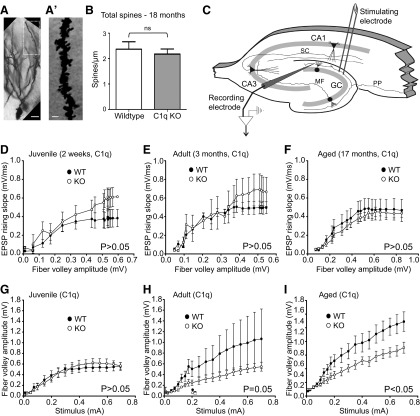Figure 7.
C1q-deficiency impacts the neuronal circuitry in the dentate gyrus of adult and aging mice. A, Representative example of a Golgi-stained dentate gyrus granule cell neuron and the approximate dendritic segment (boxed area) used for the dendritic spine quantification analysis from an 18-month-old mouse. A representative higher-magnification image of a tertiary dentate gyrus granule cell dendrite segment in the outer molecular layer, used for quantification, is shown in A′. B, Tertiary dentate gyrus granule cell dendrites in the outer molecular layer of the dentate gyrus from 18 months old C1q wild-type (WT) and C1q-deficient (KO) littermate mice were identified and traced in Neurolucida (MBF Bioscience) and dendritic spines were manually identified, counted and quantified as number of spines per μm dendrite length. No significant differences in total spine number per μm dendrite length were detected (p = 0.47; n = 4 animals/genotype). C, Schematic drawing of the stimulation and recording positions within the dentate gyrus ML. PP, Peforant path; GC, granule cell layer; MF, mossy fibers; SC, Schaffer collaterals. D–F, I/O curves showing the relationship between the presynaptic compound action potential (fiber volley) and the fEPSP in the ML were not significantly different in juvenile (D; P14–P17, p = 0.896), adult (E; 3 months, p = 0.284) or aged (F; 17-month-old, p = 0.494) C1q-deficient (KO) mice, compared with their wild-type (WT) littermates. G, I/O curves showing the relationship between stimulus strength and the fiber volley were not statistically different between juvenile WT and KO mice (p = 0.86) but significantly smaller in the adult KO (H; p = 0.05) and in the aged KO (I; p = 0.0486), when compared with their respective WT littermates. Juvenile: n = 6 WT, n = 6 C1q KO littermates; adult: n = 10 WT, n = 12 C1q KO littermates; aged: n = 13 WT, n = 11 C1q KO littermates. Values and error bars represent mean ± SEM.

